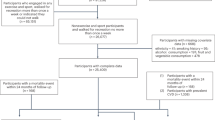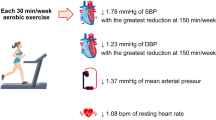Abstract
Controversy surrounds whether to define resting diastolic blood pressure (DBP) as the onset of the fourth or fifth Korotkoff phase (K4, sound muffling, or K5, sound disappearance) in children and adolescents. Although undetectable in some children (due to sounds continuing to zero cuff pressure), K5 is currently recommended for consistency with adult practice and because K4 can be difficult to discern or undetectable. However, to our knowledge, no studies have specifically assessed the reliability of measuring DBP with K4 and K5 in children and adolescents under exercise conditions. We therefore measured DBP before and immediately after a Bruce protocol stress test in 90 children and adolescents aged 12.3 ± 3.5 years (mean ± SD) in a cardiology clinic setting. When detected, K4 and K5 were 63.5 ± 9.2 and 60.2 ± 12.6 mmHg, respectively, at rest and 59.2 ± 14.6 mmHg (p = 0.028 vs rest) and 52.9 ± 18.3 mmHg (p < 0.001), respectively, immediately post-exercise. K4 and K5 were not detected in 41% and 4% of participants at rest or in 29% and 37% post-exercise, respectively, while K5 resulted in unrealistic DBP values (<30 mmHg) in an additional 11%. Better exercise performance was associated with a more frequent absence of K5 post-exercise, and after excluding participants performing at <10th percentile for age, post-exercise K4 was absent in 23%, and plausible K5 values were not obtained in 59% (p < 0.001). Although neither K4 nor K5 alone were reliable measures of DBP immediately post-exercise, a novel hybrid approach using K4, if detected, or K5, if not, produced reasonable DBP measurements in 97% of participants.
This is a preview of subscription content, access via your institution
Access options
Subscribe to this journal
Receive 12 print issues and online access
$259.00 per year
only $21.58 per issue
Buy this article
- Purchase on Springer Link
- Instant access to full article PDF
Prices may be subject to local taxes which are calculated during checkout
Similar content being viewed by others
References
Yang L, Magnussen CG, Yang L, Bovet P, Xi B. Elevated blood pressure in childhood or adolescence and cardiovascular outcomes in adulthood: a systematic review. Hypertension. 2020;948–55. https://doi.org/10.1161/HYPERTENSIONAHA.119.14168.
Theodore RF, Broadbent J, Nagin D, Ambler A, Hogan S, Ramrakha S. et al. Childhood to early mid-life systolic blood pressure trajectories: early life predictors, effect modifiers, and adult cardiovascular outcomes. Hypertension. 2015;66:1108–15. https://doi.org/10.1161/HYPERTENSIONAHA.115.05831.CHILDHOOD.
Juonala M, Magnussen CG, Venn A, Dwyer T, Burns TL, Davis PH, et al. Influence of age on associations between childhood risk factors and carotid intima-media thickness in adulthood: The cardiovascular risk in young finns study, the childhood determinants of adult health study, the bogalusa heart study, and the muscatine st. Circulation. 2010;122:2514–20. https://doi.org/10.1161/CIRCULATIONAHA.110.966465.
Chen X, Wang Y. Tracking of blood pressure from childhood to adulthood: a systematic review and meta-regression analysis. Circulation. 2008;117:3171–80. https://doi.org/10.1161/CIRCULATIONAHA.107.730366.
Hao G, Wang X, Treiber FA, Harshfield G, Kapuku G, Su S. Blood pressure trajectories from childhood to young adulthood associated with cardiovascular risk. Hypertension. 2017;69:435–42. https://doi.org/10.1161/HYPERTENSIONAHA.116.08312.
Sylvestre MP, Kâ K, Dugas EN, Zappitelli M, O’Loughlin J. Sex-specific trajectories of systolic and diastolic blood pressure in youth. J Hypertens. 2017;35:1416–23. https://doi.org/10.1097/HJH.0000000000001322.
Sundström J, Neovius M, Tynelius P, Rasmussen F. Association of blood pressure in late adolescence with subsequent mortality: cohort study of Swedish male conscripts. Br Med J. 2011;342:483 https://doi.org/10.1136/bmj.d643.
Mahoney LT, Schieken RM, Clarke WR, Lauer RM. Left ventricular mass and exercise responses predict future blood pressure. The muscatine study. Hypertension. 1988;12:206–13. https://doi.org/10.1161/01.HYP.12.2.206.
Lurbe E, Cifkova R, Cruickshank JK, Dillon MJ, Ferreira I, Invitti C, et al. Management of high blood pressure in children and adolescents: recommendations of the european society of hypertension. J Hypertens. 2009;27:1719–42. https://doi.org/10.1097/HJH.0b013e32832f4f6b.
Flynn JT, Kaelber DC, Baker-Smith CM, Blowey D, Carroll AE, Daniels SR, et al. Clinical practice guideline for screening and management of high blood pressure in children and adolescents. Pediatrics. 2017;140:1–72.
Biro FM, Darziels SX, Similo SL, Baton BA, Payne GH. Differential classification of blood pressure by fourth and fifth Korotkoff phases in school-aged girls. Am J Hypertens. 1996;9:242–7.
Elkasabany AM, Urbina EM, Daniels SR, Berenson GS. Prediction of adult hypertension by K4 and K5 diastolic blood pressure in children: the bogalusa heart study. J Pediatr. 1998;132:687–92. https://doi.org/10.1016/S0022-3476(98)70361-0.
Butani L, Morgenstern BZ. Are pitfalls of oscillometric blood pressure measurements preventable in children? Pediatr Nephrol. 2003;18:313–8. https://doi.org/10.1007/s00467-003-1075-7.
Moss AJ. Criteria for diastolic pressure: revolution, counterrevolution, and now a compromise. Pediatrics. 1983;71:854–5.
Moss AJ, Adams FH. Index of indirect estimation of diastolic blood pressure. Am J Dis Child. 1963;106:364–7. https://doi.org/10.1001/archpedi.1963.02080050366004.
Londe S. Fifth versus fourth Korotkoff phase. Pediatrics. 1985;76:460–1.
Rosner B, Polk BF. The implications of blood pressure variability for clinical and screening purposes. J Chronic Dis. 1979;32:451–61. https://doi.org/10.1016/0021-9681(79)90105-X.
O’Sullivan J, Allen J, Murray A. A clinical study of the Korotkoff phases of blood pressure in children. J Hum Hypertens. 2001;15:197–201. https://doi.org/10.1038/sj.jhh.1001140.
Londe S, Klitzner TS. Auscultatory blood pressure measurement - effect of pressure on the head of the stethoscope. West J Med. 1984;141:193–5.
Uhari M, Nuutinen M, Turtinen J, Pokka T. Pulse sounds and measurement of diastolic blood pressure in children. Lancet. 1991;338:159–61. https://doi.org/10.1016/0140-6736(91)90145-F.
Sinaiko AR, Gomez-Marin O, Prineas RJ. Diastolic fourth and fifth phase blood pressure in 10—15-year-old children. Am J Epidemiol. 1990;132:647–55.
Freedman DS, Foltz JL, Berenson GS. Differences between the fourth and fifth Korotkoff phases among children and adolescents. Am J Hypertens. 2014;27:1495–502. https://doi.org/10.1093/ajh/hpu064.
Hammond IW, Urbina EM, Wattigney WA, Bao W, Steinmann WC, Berenson GS. Comparison of fourth and fifth Korotkoff diastolic blood pressures in 5 to 30 year old individuals. Am J Hypertens. 1995;8:1083–9.
National High Blood Pressure Education Program Working Group on Hypertension Control in Children and Adolescents. Update on the 1987 task force report on high blood pressure in children and adolescents: a working group report from the National High Blood Pressure Education Program. Pediatrics. 1996;88:649–58.
Allison TG, Cordeiro MAS, Miller TD, Daida H, Squires RW, Gau GT. Prognostic significance of exercise-induced systemic hypertension in healthy subjects. Am J Cardiol. 1999;83:371–5. https://doi.org/10.1016/S0002-9149(98)00871-6.
Thanassoulis G, Lyass A, Benjamin EJ, Larson MG, Vita JA, Levy D, et al. Relations of exercise blood pressure response to cardiovascular risk factors and vascular function in the framingham heart study. Circulation. 2012;125:2836–43. https://doi.org/10.1161/CIRCULATIONAHA.111.063933.
Yzaguirre I, Grazioli G, Domenech M, Vinuesa A, Pi R, Gutierrez J, et al. Exaggerated blood pressure response to exercise and late-onset hypertension in young adults. Blood Press Monit. 2017;22:339–44. https://doi.org/10.1097/MBP.0000000000000293.
Paridon SM, Alpert BS, Boas SR, Cabrera ME, Caldarera LL, Daniels SR, et al. Clinical stress testing in the pediatric age group: a statement from the American Heart Association council on cardiovascular disease in the young, committee on atherosclerosis, hypertension, and obesity in youth. Circulation. 2006;113:1905–20. https://doi.org/10.1161/CIRCULATIONAHA.106.174375.
Sharman JE, Lagerche A. Exercise blood pressure: clinical relevance and correct measurement. J Hum Hypertens. 2015;29:351–8. https://doi.org/10.1038/jhh.2014.84.
Washington RL, Bricker JT, Alpert BS, Daniels SR, Deckelbaum RJ, Fisher EA, et al. Guidelines for exercise testing in the pediatric age group: from the Committee on Atherosclerosis and Hypertension in Children, Council on Cardiovascular Disease in the Young, the American Heart Association. Circulation. 1994;90:2166–79. https://doi.org/10.1161/01.CIR.90.4.2166.
Alpert BS, Fox ME. Blood pressure response to dynamic exercise. In Rowland TW, editor, Pediatric laboratory exercise testing: clinical guidelines, 1st ed. Champaign, Illinois, USA: Human Kinetics; 1993. p. 67–90.
Møller NC, Grøntved A, Wedderkopp N, Ried-Larsen M, Kristensen PL, Andersen LB, et al. Cardiovascular disease risk factors and blood pressure response during exercise in healthy children and adolescents: the European youth heart study. J Appl Physiol. 2010;109:1125–32. https://doi.org/10.1152/japplphysiol.00316.2010.
Alpert BS, Dover EV, Booker DL, Martin AM, Strong WB. Blood pressure response to dynamic exercise in healthy children-black vs white. J Pediatr. 1981;99:556–60. https://doi.org/10.1016/S0022-3476(81)80253-3.
Bruce R, Kusumi F, Hosmer D. Maximal oxygen intake and nomographic assessment of functional aerobic impairement in cardiovascular disease. Am Heart J. 1973;85:546–62.
Cumming GR, Everatt D, Hastman L. Bruce treadmill test in children: normal values in a clinic population. Am J Cardiol. 1978;41:69–75. https://doi.org/10.1016/0002-9149(78)90134-0.
Gardner MJ, Altman DG. Statistics with confidence: confidence intervals and statistical guidelines. 1st ed. London: BMJ Publishing; 1989.
Benmira A, Perez-Martin A, Schuster I, Veye F, Triboulet J, Berron N, et al. An ultrasound look at Korotkoff sounds: the role of pulse wave velocity and flow turbulence. Blood Press Monit. 2017;22:86–94. https://doi.org/10.1097/MBP.0000000000000231.
Drzewiecki GM, Melbin J, Noordergraaf A. The Korotkoff sound. Ann Biomed Eng. 1989;17:325–59. https://doi.org/10.1007/BF02368055.
Park MK, Menard SW, Yuan C. Comparison of auscultatory and oscillometric blood pressures. Arch Pediatr Adolesc Med. 2001;155:50–53.
Flynn JT, Pierce CB, Miller ER, Charleston J, Samuels JA, Kupferman J, et al. Reliability of resting blood pressure measurement and classification using an oscillometric device in children with chronic kidney disease. J Pediatr. 2012;160:434–440.e1. https://doi.org/10.1016/j.jpeds.2011.08.071.
Wong SN, Rita RY, Leung LCK. Validation of three oscillometric blood pressure devices against auscultatory mercury sphygmomanometer in children. Blood Press Monit. 2006;11:281–91. https://doi.org/10.1097/01.mbp.0000209082.09623.b4.
Mynard JP, Goldsmith G, Springall G, Eastaugh L, Lane GK, Zannino D, et al. Central aortic blood pressure estimation in children and adolescents. J Hypertens. 2020;38:821–8. https://doi.org/10.1097/hjh.0000000000002338.
Muntner P, Shimbo D, Carey RM, Charleston JB, Gaillard T, Misra S, et al. Measurement of blood pressure in humans: a scientific statement from the American Heart Association. Hypertension. 2019;73:E35–E66. https://doi.org/10.1161/HYP.0000000000000087.
Acknowledgements
Funding
This work was supported by a grant from the National Health and Medical Research Council of Australia (APP1128516). JPM is supported by a co-funded R.D. Wright Career Development Fellowship from the National Health and Medical Research Council of Australia (APP1143510) and Future Leader Fellowship from the National Heart Foundation of Australia (101866). The Heart Research Group is supported by the Victorian Government’s Operational Infrastructure Support Program, RCH 1000 and Big W.
Author information
Authors and Affiliations
Corresponding author
Ethics declarations
Conflict of interest
JPM is a consultant for the Brain Protection Company, Tournicare, Masimo Corporation and Baxter Healthcare; none of these consultancies have any relation to the present work. All other authors declare no competing interests.
Additional information
Publisher’s note Springer Nature remains neutral with regard to jurisdictional claims in published maps and institutional affiliations.
Rights and permissions
About this article
Cite this article
Glenning, J.P., Lam, K., Clarke, M.M. et al. Assessment of diastolic blood pressure with the auscultatory method in children and adolescents under exercise conditions. Hypertens Res 44, 1009–1016 (2021). https://doi.org/10.1038/s41440-021-00657-7
Received:
Revised:
Accepted:
Published:
Issue Date:
DOI: https://doi.org/10.1038/s41440-021-00657-7



